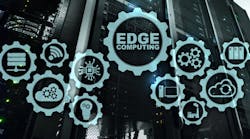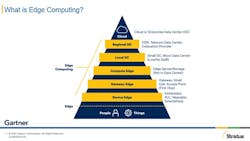Why manufacturers' data is best analyzed at the edge
The pace of business is accelerating. For any organization that wants to stay competitive in this marketplace, the ability to tap into real-time data and analytics has quickly gone from an aspiration to a must-have component of operations. Many businesses have been leveraging the cloud and on-premises systems for their analytical needs. While those systems work well enough some of the time, integrating insights into operations requires access to real-time data and analytics where it’s generated—the edge.
See also: Securing manufacturing operations: Why zero trust at the PLC level is critical
Edge computing solutions get right at the heart of where data is generated to help act on real-time insights on the spot. Implementing edge computing makes real-time analytics possible by cutting down on latency and eliminating the need for storing data in one physical location and then having to move it back and forth between environments. Businesses in Industry 4.0 have begun embracing edge solutions for those exact reasons. For organizations that operate with many remote endpoints and sites generating data, edge computing is a must-have to achieve their goals.
But those benefits aren’t confined to just one industry. Let’s look at a few of the main benefits edge computing can deliver to businesses looking to achieve and take advantage of real-time data analytics.
What is edge computing
The Gartner model illustrates how the industrial world is embedding edge computing at different levels of their manufacturing processes. When everyone started pumping data to the cloud, manufacturers began discovering that they could mine valuable insights by watching specific data points. The problem was, they could not act on them in a fast or efficient manner from the cloud.
This is why manufacturers had to adopt edge computing. As the Gartner model shows, edge computing can be embedded at different places so that users can implement action where it matters, on the production floor. The key is to only move data as far as necessary from production while still maximizing the value achieved from the data. The Gartner model shows how companies have implemented flexible and efficient ways to do this to support all different kinds of processes.
Edge fuels cost savings
Regardless of the tools at play, there’s one certainty with data analytics—it comes at a cost. Everything from storing data, to processing it, to moving it from one environment to another has an associated financial cost. But with edge computing, there’s significant potential for limiting those costs and driving meaningful savings. By leveraging edge computing to conduct analytics, users eliminate expensive back-end processing and data transportation costs along the way.
There’s also the added benefit of limiting data egress fees—a cost that can easily get out of control when managing cloud operations. In a hybrid cloud system driven with edge solutions, it’s easier to manage data and keep those costs down as much as possible.
Processes that would otherwise involve a high volume of back and forth between cloud systems and on-premises systems can be automated at the edge, and outcomes reported to the cloud. Adding that level of control enables actions to be taken swiftly before something goes wrong—say, for example, a failure mode is triggered on a machine or process, and action is implemented before any loss occurs.
Boosting scalability and security at the edge
Edge computing, by its very nature, is highly customizable and scalable—a major asset for businesses that have unique operational processes and varying environments. Edge computing’s advantage lies in its ability to have each machine analyze its own data, and most importantly, make decisions that impact operational KPIs. The solution remains incredibly scalable, distributing the computational workload across sites or machines. As a business grows and operations expand, edge solutions provide a flexible foundation to ensure that analytical capabilities won’t fall behind, even as the number of locations and endpoints rises.
See also: Contracted tech workers paid less than regular IT staff, report says
In addition to scalability, edge computing brings a number of security benefits to the table, too. As the volume of data in an organization expands, so too do the security concerns. With edge solutions, analytics doesn’t have to come with undue risk. Because edge analytics happens at the place where data is generated, there’s no need to transmit and expose data.
The data that is needed for analytics never needs to leave the location that generated it in the first place. Edge computing can help expand the reach of security teams, giving them a complete, real-time indication of operations while also ensuring that systems are kept up-to-date with the latest patches and updates.
Edge cuts down on latency
One of the most important advantages that edge computing delivers is a reduction in latency. For an organization that depends on data to help drive decision-making, latency is a major concern. In edge analytics, the analysis happens where data is generated, without any time spent moving from one environment to another before making its way to the end-user who can actually take action.
For an organization looking to launch any sort of transformation project, real-time analytics are a must. Edge computing brings analytics directly to sensors and network devices to help cut down on the processing strain associated with enterprise data management, particularly as the volume of data grows. No matter where a business finds itself in terms of modernization efforts, market competition, or overall capabilities, good decision-making means nothing if an organization cannot act on it quick enough. Analytics powered by edge computing help support those decisions and ensure the information that is gathered and relayed to the end-user is reliable and actionable.
Analyzing data starts at the edge
Real-time analytics has become a critical tool for success. As more organizations look for ways to take advantage of their internal data, edge computing offers a powerful means for them to not only tap into data to make more informed, but capitalize also while simultaneously boosting security. With modernization efforts and the pace of business only growing more intense in the years to come, edge computing provides a critically important set of tools to take full advantage of game-changing analytical capabilities at scale.





